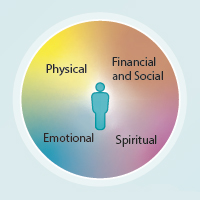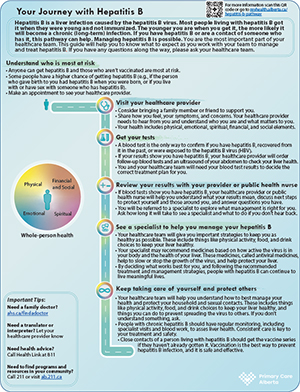This guide will help you to know what to expect as you work with your healthcare team to manage and treat
hepatitis B. You may find this guide helpful if you have hepatitis B or if you are a contact of someone who has it.
You will have your own unique journey with hepatitis B. How you move through your journey, the number of visits with your healthcare team, the steps you will take, and the order you take them in will depend on your needs. You will make decisions in partnership with your healthcare team. Always follow your healthcare team’s advice.
What is hepatitis B?
Hepatitis B is a liver infection caused by the hepatitis B virus (HBV). You can prevent this infection by getting
immunized against hepatitis B. Most people living with hepatitis B got it when they were young and not immunized. For those who have hepatitis B, treatment can stop or slow the growth of the virus and protect your liver.
Hepatitis B can impact your liver’s ability to function properly. Most people who have hepatitis B don’t realize they have it and either have no symptoms or only mild symptoms. Sometimes, hepatitis B can cause chronic (long-lasting) hepatitis B infection that can cause liver damage (called cirrhosis), liver cancer, and death. The younger you are when you get infected with hepatitis B, the greater the chance of developing chronic infection.
Hepatitis B is a sexually transmitted and blood-borne infection. This means it spreads through contact with blood or body fluids that have the virus, like semen or vaginal secretions. People with hepatitis B can spread the virus to others even if they don’t have symptoms. Most people who have chronic hepatitis B can spread the virus to others for the rest of their lives.
There are certain factors that put you at a higher risk of hepatitis B:
- You were born before 1982 in Canada.
- You have never gotten the hepatitis B vaccine series.
- The person who gave birth to you had hepatitis B when you were born. Exposure during childbirth is the most common way hepatitis B spreads.
- You live with, had sex with, or had close contact with someone who has hepatitis B.
- You lived in or travelled to a
country that has high rates of hepatitis B.
- You are on dialysis.
- You share equipment for drug use, like pipes, straws, spoons, needles, syringes, and cookers.
- You live, lived, or work in a place where people who are not related live or sleep and share common spaces, like a shelter or correctional facility. These are also called congregate living places.
- You got blood products outside of Canada or got blood products in Canada before 1972.
Learn more about
hepatitis B, who is most at risk, how it spreads, and how to prevent it.
If you think you were exposed to hepatitis B virus
If you think you were exposed to the hepatitis B virus and have not received the full vaccine series, call Health Link at 811 right away. You should be assessed as soon as possible after the exposure to see if you can be treated with
hepatitis B immunoglobulin for quick, short-term protection from the exposure. You can get this treatment at a hospital or local public health office. For long-term protection, you should get the hepatitis B vaccine.
Getting these treatments as soon as possible after exposure (within 7 days after a needle stick injury and within 2 weeks after sexual contact with someone who has hepatitis B) is important for the treatment to be successful.
Whole-person health
The whole-person health approach will help you and your healthcare team better manage your health condition.

Whole-person health draws from the teachings of the medicine wheel. It means thinking about all parts of your health and wellness:
- physical
- financial and social
- spiritual
- emotional
These parts are all connected and impact each other. It’s important to be aware of your personal needs in each part and to share that information with your healthcare team. Your healthcare team needs to understand who you are and what matters to you.
Here are some examples of things you may want to talk about with your healthcare provider:
- “What symptoms should I watch for?” (physical)
- “I need to be at work to get a pay cheque. How does hepatitis B affect my employment?” (financial and social)
- “How can I include my culture’s foods and family recipes in my nutrition plan?” (spiritual)
- “I’m worried about the health of my loved ones. I don’t want to give them hepatitis B.” (emotional)
Support and resources
- If you need a family doctor, visit Alberta Health Services:
Find a doctor.
- If you need a translator, let your healthcare provider know.
- If you need health advice any time, day or night, call Health Link at 811.
- If you need to find programs and services in your community, call or text 211 or visit
211 Alberta.
For more information about hepatitis B, see:

Hepatitis B Pathway
Download or print the
full patient pathway (PDF) and
summary (one-page PDF) to learn more about how to manage and treat hepatitis B.
Patient Pathway  Summary
Summary 
